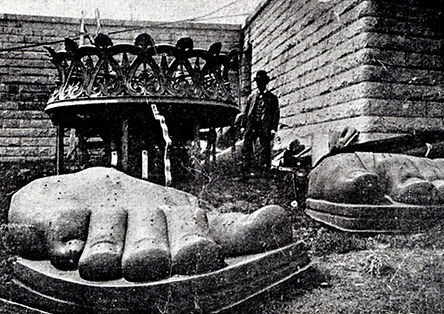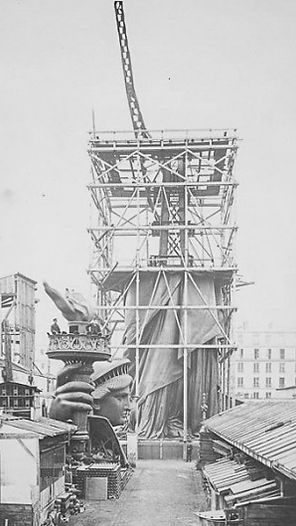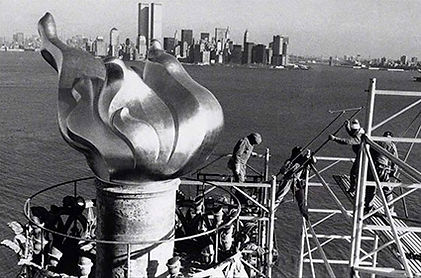The Statue of Liberty
Frenchman Edouard de Laboulaye first proposed the idea of a monument for the United States in 1865. Ten years later sculptor Frederic Auguste Bartholdi was commissioned to design a sculpture with 1876 in mind for completion, to commemorate the centennial of the American Declaration of Independence.
The Statue was named “Liberty Enlightening the World” and was a joint effort between America and France.
It was agreed that the American people were to build the pedestal, and the French people were responsible for the Statue and its assembly here in the United States. However, lack of funds was a problem on both sides of the Atlantic Ocean. In France, public fees, various forms of entertainment, and a lottery were among the methods used to raise funds.
In the United States, benefit theatrical events, art exhibitions, auctions and prizefights assisted in providing needed funds.


Meanwhile in France, Bartholdi required the assistance of an engineer to address structural issues associated with designing such a colossal copper sculpture. Alexandre Gustave Eiffel (designer of the Eiffel Tower) was commissioned to design the massive iron pylon and secondary skeletal framework which allows the Statue's copper skin to move independently yet stand upright; he also used asbestos impregnated with shellac to limit the long-term corrosion.
Bartholdi designed the Statue of Liberty like a giant puzzle.
Over 300 thin sheets of copper, most of it from a copper mine in Karmoy, Norway, fit together to form the Statue's outer skin.
Each copper sheet is 3/32 of an inch thick (2,38 mm), about the thickness of two pennies.



Back in America, fundraising for the pedestal was going particularly slowly, so Joseph Pulitzer opened up the editorial pages of his newspaper, "The World," to support the fundraising effort.
Architect Richard Morris Hunt designed the Statue of Liberty's granite pedestal in 1884, donating his fee to help fund the Statue. In 1883, Lazarus donated her poem, "The New Colossus" to an auction raising funds for the construction of the Statue's pedestal.
Financing for the pedestal was completed in August 1885, and pedestal construction was finished in April 1886.
The Statue was completed in France in July 1884 and arrived in New York Harbor in June 1885 onboard the French frigate "Isere."
In transit, the Statue was reduced to 350 individual pieces and packed in 214 crates. The Statue was reassembled on her new pedestal in four months’ time.
On October 28, 1886, President Grover Cleveland oversaw the dedication of the Statue of Liberty in front of thousands of spectators. She was a centennial gift ten years late


The Statue was placed upon a granite pedestal inside the courtyard of the star-shaped walls of Fort Wood (which had been completed for the War of 1812).
The United States Lighthouse Board had responsibility for the operation of the Statue of Liberty until 1901, when the care and operation of the Statue was placed under the War Department.
A Presidential Proclamation declared Fort Wood (and the Statue of Liberty within it) a National Monument on October 15, 1924, and the monument's boundary was set at the outer edge of Fort Wood. In 1933, the care and administration of the National Monument was transferred to the National Park Service.
On September 7, 1937, jurisdiction was enlarged to encompass all of Bedloe's Island and in 1956, the island's name was changed to Liberty Island. On May 11, 1965, Ellis Island was also transferred to the National Park Service and became part of the Statue of Liberty National Monument.




Between 1886 and 1924, almost 14 million immigrants entered the United States through New York.
The Statue of Liberty was a reassuring sign that they had arrived in the land of their dreams.
To these anxious newcomers, the Statue's uplifted torch did not suggest "enlightenment," as her creators intended, but rather, "welcome." Over time, Liberty emerged as the "Mother of Exiles," a symbol of hope to generations of immigrants.
The opening of the immigrant processing station at Ellis Island in 1892 in the shadow of the Statue of Liberty facilitated an immigrant association, as did the later popularity of Emma Lazarus's poem, "The New Colossus".
This poem vividly depicted the Statue of Liberty as offering refuge to new immigrants from the miseries of Europe. The poem received little attention at the time, but in 1903 was engraved on a bronze plaque and affixed to the base of the Statue.
Frédéric-Auguste Bartholdi's monument took the form of a colossal statue of a woman dressed in classical Roman clothing, Symbolizing the Roman goddess of Liberty.
She wears a crown of seven rays representing a nimbus or halo.
In her left hand she carries a tablet bearing the date July 4, 1776 in Roman numerals to commemorate American's birth as an independent nation.
The torch in her right hand represent liberty enlightening the world.
Beneath her feet are severed shackles and chains representing the universal symbol of freedom and the abolition of slavery in the United States.

In May of 1982, President Ronald Reagan appointed Lee Iacocca, Chairman of Chrysler Corporation, to head up a private sector effort to restore the Statue of Liberty. Fundraising began for the $87 million restoration under a public/private partnership between the National Park Service and The Statue of Liberty-Ellis Island Foundation, Inc., to date the most successful public-private partnership in American history.
A team of French and American architects, engineers, and conservators came together to determine what was needed to ensure the Statue's preservation into the next century. In 1984, scaffolding was erected around the exterior of the Statue and construction began on the interior.
Workers repaired holes in the copper skin and removed layers of paint from the interior of the copper skin and internal iron structure.
They replaced the rusting iron armature bars (which joined the copper skin to the Statue's internal skeleton) with stainless steel bars.
The flame and upper portion of the torch had been severely damaged by water and was replaced with an exact replica of Bartholdi's original torch, which was gilded according to Bartholdi's original plans.
On July 5, 1986, the newly restored Statue reopened to the public during Liberty Weekend, which celebrated her centennial.


